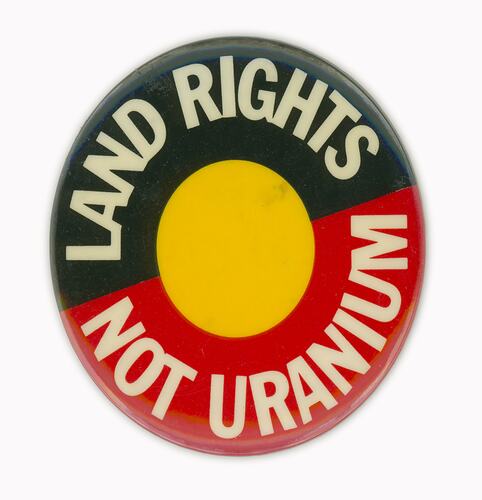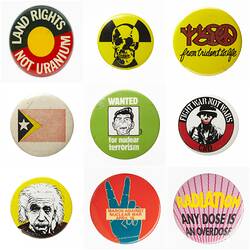Summary
Alternative Name(s): Button
Already-existing concerns over Aboriginal land rights were enhanced by the advent of the modern Australian mining industry at the end of the 1950s, as the areas of interest in terms of uranium deposits were also centres that preserved the traditional Aboriginal life. The anti-uranium movement and the Aboriginal land rights movement were united under a common goal, as is evident in this badge. In the 1960s and 1970s activists from the anti-nuclear movement started supporting the local Aboriginal resistance. "Land Rights Not Uranium" was used as a theme in many protests and demonstrations at the time.
Australia holds one of the world's biggest reserves of uranium and the demand for this material increased significantly in the tense post-war climate. Mining at the Ranger mine in Kakadu, Northern Territory began as early as 1956 and it is one of three main uranium mines in Australia. As Northern Territory is inhabited by many Aboriginal communities, they were primarily affected by the mining activity in the area. One of the main problems was the mine's impact on the health of the locals, due to contaminated water, long term impacts on the food chain and the environment. Moreover, there are aspects that span beyond health issues, as some communities hold the belief that they bear the responsibility of what happens on their territory and are therefore responsible if the uranium is used for manufacturing nuclear weapons.
The issue of land rights depends on whether Indigenous people are classified as Traditional Owners and whether they possess native title rights. Traditional Owners with native title are able to negotiate for compensation with mining companies who are either exploring or mining on Indigenous land. Refusal to engage in negotiations with a mining company could easily result in a court case. In many cases the communities have no power to prevent mining, they only have the right to be consulted. In 1978 the mining companies convinced the relevant communities in the Northern Territory to sign an agreement allowing the developments. However, many felt that it was merely unscrupulous lobby and manipulation of the part of the mining companies.
Physical Description
Circular badge with black background u. and red background l. Yellow circle design in the form of an Aboriginal flag c. White printed text around the edge of the badge. Pin on the back.
More Information
-
Collecting Areas
Public Life & Institutions, Politics & Society, Cultural Diversity, Clothing & Textiles
-
Acquisition Information
Donation from Nic Maclellan, 23 Feb 1987
-
Inscriptions
Printed text; LAND RIGHTS/ NOT URANIUM
-
Classification
-
Category
-
Discipline
-
Type of item
-
overall dimensions
5.5 cm (Height)
-
Keywords
Economic Geology, Indigenous Peoples, Land Rights, Political Protests, Protest Movements, Uranium Mining, Anti-Nuclear Protests, Uranium Mines, Peace Movements, Peace, Activism, Disarmament Protests, Environmental Activism



